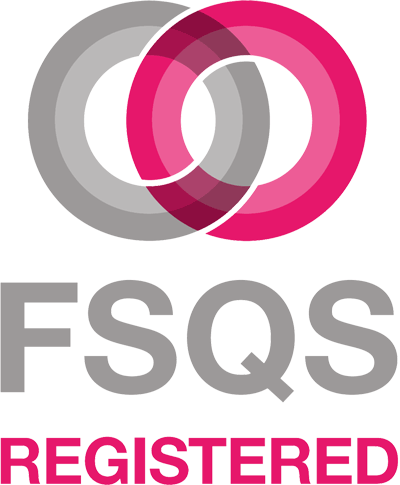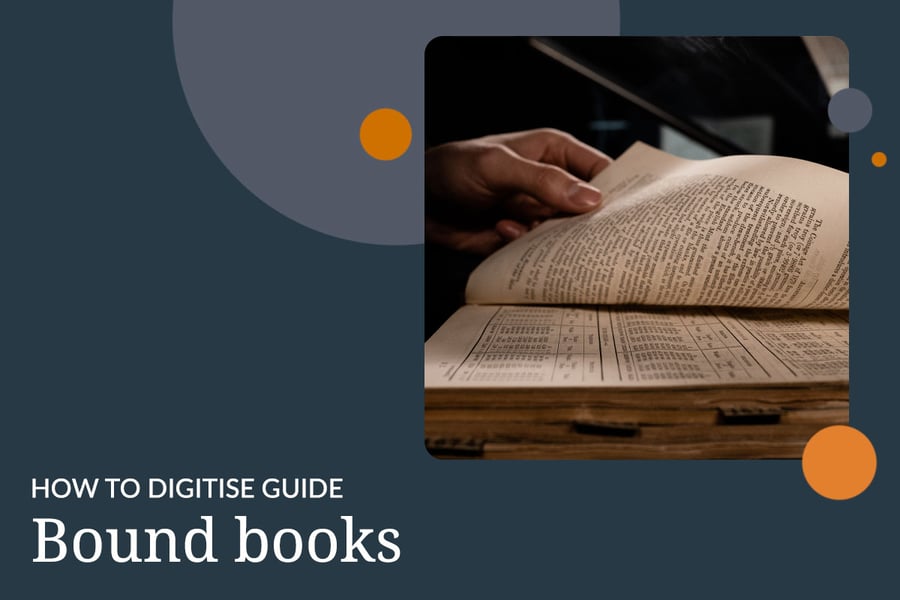
Digitising Bound Book collections is becoming increasingly popular as many archival institutions look to make their collections more accessible.
Our specialist technicians have digitised books of all shapes and sizes, from standard leather-bound volumes to Guard books, and large format to burial registers. As a result, they know all of the key media-specific challenges that can arise with this particular type of material.
To help you better understand what’s involved when it comes to digitising bound book collections, we’ve combined our in-house expertise, and years of industry experience, to create 8 Top Tips. These should help to explain the specific practices we follow, ensuring top quality digitisation results, every time.
Digitising Bound Book Archives – 8 Top Tips
1. Survey the books first
Checking the condition of the books that you are looking to digitise, to ensure they are in a suitable state to withstand the scanning process, is a vital first step.
The books should be assessed for general fragility and brittleness, as well as mould and other signs of damage. If any of these things are found to be present on a particular volume, it may need to undergo a conservation process prior to digitisation, to repair and stabilise the condition.
Establishing workflow is another good reason for surveying the entire collection in advance of digitisation. Imagine setting up to digitise small items and then, part way through, you come across a larger item that doesn't fit in your zoom. This would require you to repeatedly set up again and again, slowing the process and impacting on time. We always set up on the largest item, so colour settings remain consistent throughout. The higher you zoom out the more light you let in, impacting the images if you change midway through.
2. Mind the binding
Binding presents one of the biggest challenges when digitising book collections.
Even moderately tight binding can cause curvature around the gutter (the area between two pages) and create distorted scans, particularly distorting text nearest the gutter. This curvature tends to be more prominent in thicker volumes, and can present a significant problem if you plan to OCR the text from the digital images.
The good news is that curvature can be minimised through the combined use of adjustable book cradles and a low pressure glass screen (assuming a Book or Planetary Scanner is being used). This helps to flatten the pages without placing stress on the book. Adjustable book cradles will help to protect the spine, which is the most important and often most fragile part of the book (as illustrated in the image below).
The curvature caused by binding can also prevent light properly reaching the gutter area, resulting in dark areas on the scanned images. This can usually be mitigated by rotating the book, so lighting is projected along the gutter instead of across it.

3. Use fluorescent or LED lighting
Incandescent (or heat producing) lighting can damage the paper, dye or inks of archival books (and other paper-based media). Specifically, it can cause the paper to fade or darken, as well as causing it to become brittle. This is due to the breakdown of the cellulose fibres that make up the paper.
To mitigate potential light damage to bound volumes, only fluorescent or LED (light-emitting diode) lighting should be used to illuminate books during scanning. This lighting produces far less heat and infrared energy. It is now also possible to source LED daytime lights, which offer a lighter yellow to imitate the sun.
4. Follow archival handling procedures
As with any old, rare, and fragile archival media, bound volumes should be handled with care at all times. For many collections, the digitisation process is the most the material has been handled in a long time. It may even have been years since every single page was turned. This increase in handling can accelerate the normal process of wear and tear, if not done carefully.
Our guidance for handling bound volumes:
- Wash and dry hands thoroughly before handling items to minimise acidic oils that might be present on the skin
- Always support from underneath with hands or book cradles – taking particular care of the the spine
- Turn pages slowly and carefully to avoid stress and the potential for tears
We do not recommend wearing cotton gloves when digitising books as these can reduce dexterity, resulting in less delicate turning of pages and a greater risk of damage. In addition, there is a risk of fibres from the gloves catching on delicate edges, causing tears. However, if you are scanning photo albums, where the print comes close to the page, then gloves may be necessary.
For full guidelines on handling archival materials, including bound volumes, take a look at this guidance from The National Archives.
5. Capture images to an open source format
As we have noted previously, in our planning for digitisation post, the resolution and capture format you choose will depend on the goals of the digitisation project.
When planning to digitise book collections for our clients, we normally recommend scanning to produce 300ppi uncompressed master TIFF image files. If the item is too big then 200ppi may be necessary. For smaller items, using a good quality camera, 600ppi is possible. Lower resolution, compressed surrogate JPEGs can be produced from the master images to create Adobe PDF eBooks, or for display as thumbnails on the web and within digital archive management systems.
It is also worth noting that organisations and charities that fund heritage digitisation projects often require images to be captured to open-source, non-proprietary formats, as part of their criteria for funding a project.
6. Watch for movement
Even when starting with precisely calibrated equipment, a book will move slightly over the course of the scanning process. This normally takes the form of a shift from right to left as the pages are turned.
This shift is often more noticeable in smaller items where the slightest of movements can be exaggerated. However, this can be monitored and countered for by checking each image as it is captured. More advanced book scanners, such as the ones used by our technicians, feature precise laser guides to allow any movement to be immediately identified and corrected.
7. Group books by size to optimise digitisation workflow
Dividing the book collection into groups of similar sized volumes, before scanning, will help to minimise recalibration of your digitisation equipment, maximising efficiency and workflow.
It is important to consider if any of the volumes contain fold-outs (such as in the case of Guard Book collections) when grouping, as equipment may need to be recalibrated to capture these too.
8. Planetary scanners are the best equipment solution
We believe specialist planetary (or book) scanners (such as the Vanguard pictured above) are the best equipment solution for digitising bound volumes. Consequently, we use this type of scanner to digitise all of our clients’ book collections. For any items larger than A2, we use the Guardian.
Planetary scanners are preferred due to their in-built features, such as responsive, low-stress book cradles, and adjustable LED lighting, as mentioned earlier in this article.
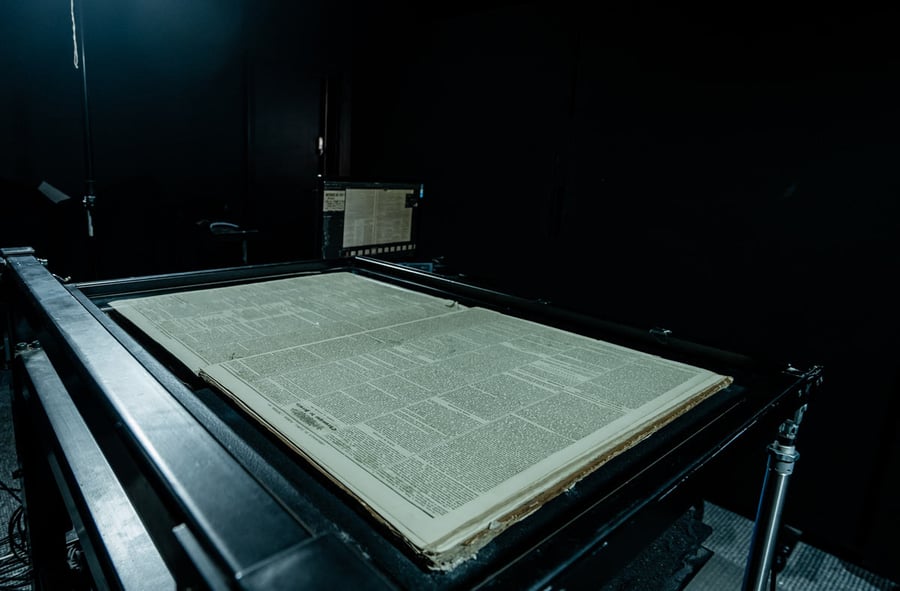
However, planetary scanners can cost tens of thousands of pounds (not including the cost of hiring and training an operator) so, unless your organisation already possesses this type of equipment, it may be more cost effective to outsource your project.
What Next?
We hope this blog proves helpful in understanding how to best digitise your bound books, and we wish you the best of luck with your project. However, should you prefer to outsource your digitisation project then take a look at the specialist services we offer below:
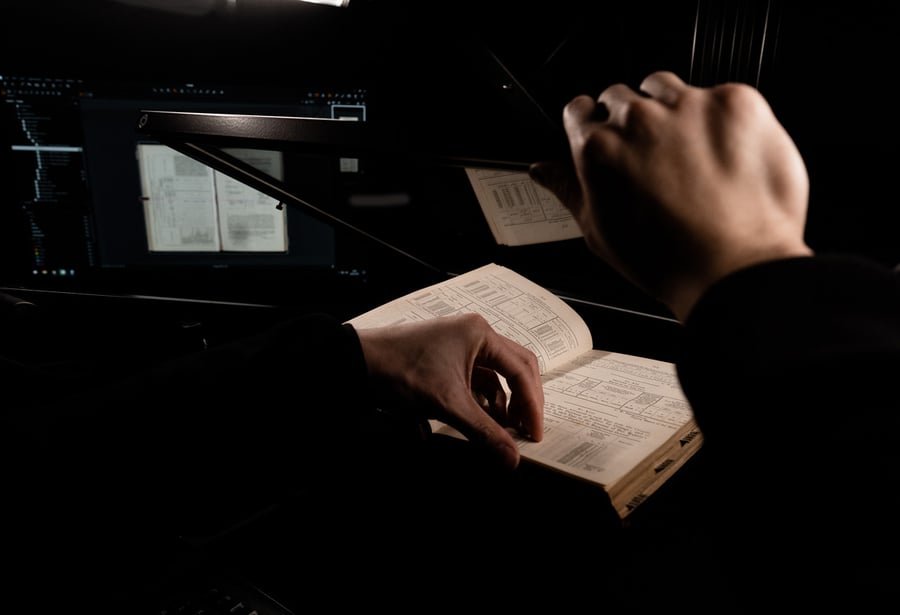
Digitisation
Our specialist planetary scanners and digitisation equipment are able to scan all of your bound book collections, and we have extensive experience in handling even the most delicate and fragile of items. We can scan your bound books at high resolution and convert them into digital formats, including TIFF and JPEG files. Our consultants are always happy to discuss your requirements so find out more about our digitisation services or contact us to discuss your individual requirements.
Data Capture
Digitisation provides the perfect opportunity to capture the valuable data contained within your bound books readying them for system integration and online access and discovery. Our handwritten transcription service, for example, can identify any handwritten or cursive script that might appear within your collection, converting this to searchable and machine readable textual metadata, outputting to any format. While Optical Character Recognition identifies typed text within digital images, converting this to digital searchable text.
PastView
Digitisation and Data Capture prime your bound book collections for fluid integration into our PastView platform, enabling you to take advantage of a full range of features for enhanced online access and discovery, such as advanced search, featured collections, 3D page turning, digital downloads, and subscriptions.
Are you looking to digitise your bound books?
TownsWeb Archiving’s digitisation technicians have a wealth of experience in book scanning and digitising bound volumes – including scanning burial registers, guard books, journals, diaries, magazines and newspapers.
We are able to scan and digitise old, fragile, and rare books of practically any size and convert these to digital formats, such as TIFF, JPEG, and full Adobe PDF eBooks.



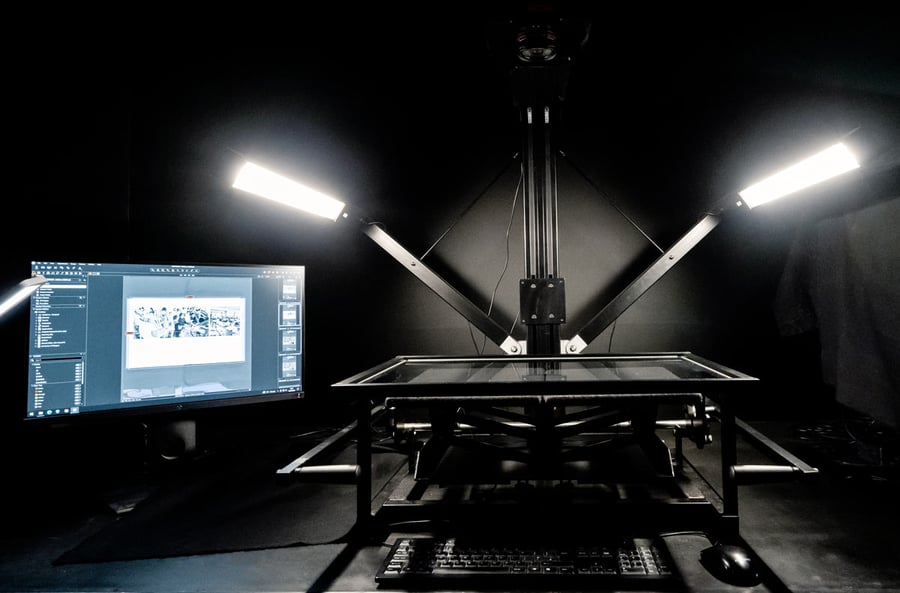

 USE OUR ONLINE
USE OUR ONLINE

